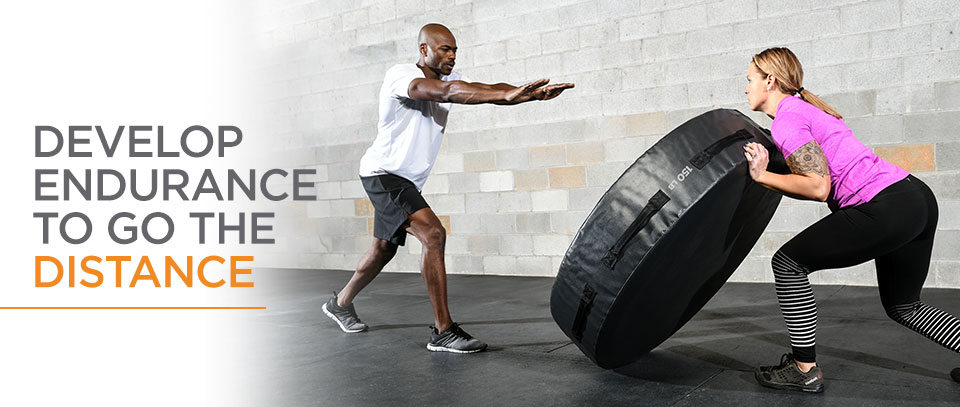As we continue to discuss the best way to train for an obstacle course race, let’s move on to the running part of the race. Running endurance – aka the ability to run and quickly transition between obstacles – will be another skill to develop for a successful OCR.
The length of the race you are training for plays a role in the type of running program you follow.
For example, there are events that require a very short transition and distance between each obstacle (like American Ninja Warrior). On the other hand, there are longer events that require long transition runs between obstacles such as marathon distance and OCR extreme challenges that can last up to 24+ hours. There are also a multitude of race distances in between, many of which fall in the 5-25k range.
For ANY distance, most OCR training will be working the anaerobic energy cycle. For everything else, building up your aerobic engine is extremely important to help you transition quickly between obstacles and allow you to conquer the obstacle once you get there.
Training for an OCR is not dissimilar from many other training programs in the fact that cross training is essential for success. Finding a balance between work, recovery, to active recovery from run days, to strength days, to flexibility days.
However, since today’s topic is how to improve your running endurance during an OCR – here are a few examples of how to structure your running sessions:
- Fartleks – A run training style developed in Sweden, aka “speed play”. The Fartlek is a form of interval training – for example, run at an easy pace for 4 min followed by an increased race tempo pace for 2 minutes, continue repeating for the length of time you have set aside to train. Fartlek training can also double as lactate tolerance training (aka increasing your efficiency as the body deals with the inevitable activity side effect of lactic acid pouring into the blood stream faster than it can be removed) This would manifest as a subtle shift in pace in which you are under your lactate threshold (for a length of time and then slightly above your lactate threshold for a period of time – usually half as long as the sub threshold run. *Always make sure the faster pacing is manageable so you can continue hitting it over and over for multiple reps with efficient running mechanics.
- Intervals – Most familiar run type for developing endurance. Simply run various distances with rest periods in between each running interval. As you develop more endurance, increase the run interval and decrease the rest interval – or – keep the run:recover interval the same and increase the speed of the run interval.
- Tempo Runs – Also called “comfortably hard” runs. These runs can be in the 20-minute range for 5k distances, 40-minute range for 10k distances, and longer in duration if training for longer OCR events.
- Long Duration Aerobic Training Zone Runs – These runs will benefit anyone, particularly if you are training for a long-distance OCR such as 15+ miles with farther distances between obstacles. These runs will be at a slower pace than a tempo run pace but will increase your aerobic capacity over time if you consistently work them in to your program.
- Bricks – Bricks are a great way to extend your aerobic training zone or tempo efforts for longer periods of time without it all being on your feet. An example would be a 40-minute bike followed by a 40-minute run.
As I said before, balancing your run days, strength days, and recovery days in a OCR cross training program is not only important for proper training but also for injury prevention. With my OCR athletes, it’s common for me to sneak in OCR specific strength training to help the body get comfortable with what it will be dealing with out on course. For most sessions, I like to tie everything together with no rest during the running to strength training transitions. This allows you to maximize training time and accomplish long duration sessions with the heart rate in zones to help achieve a strong aerobic engine.
At some point during your OCR training program, it is important to switch gears from an all run day followed by an all strength day and start to train like you race. In other words, structure your workout to mimic a race day. For example, run 5 minutes at an aerobic training zone level then stop and perform approximately 1 minute of an OCR specific strength training such as a grip & strength training exercise. Repeat this process for 30-90 mins.
Lastly, remember that many OCR events take place in geographical areas where there are a lot of hills or mountains. Hills and mountains almost always mean you will be dealing with technical terrain while ascending and descending. It’s important to make sure a significant amount of your running training is out on the trails when possible to train your neuromuscular to make thousands of quick decisions for foot placement on technical terrain.
Stay tuned for the next OCR training tip on your favorite Power Systems social network. The next tip will cover how to strengthen the area of your body that will improve your ability to run to and complete every obstacle – the CORE.
